Slide 1: Scaling Transformers: Parallelism Strategies from the Ultrascale Playbook
(Based on Hugging Face Ultrascale Playbook)
Goal: Understand why and how we train massive AI models across many computers.
Slide 2: The Scaling Challenge
Why are we here?
- Modern AI models (like Transformers) are HUGE (Billions/Trillions of parameters!).
- Too big for one computer (specifically, one GPU’s memory).
- Need to split the work across many GPUs/computers.
Today’s Focus:
- System-level challenges & strategies for distributed training.
- How to manage computation & memory across devices.
- (Not focusing on the optimization math itself).
Core Resource: Hugging Face Ultrascale Playbook (link)
Slide 3: What IS a Transformer? (The Big Picture)
Purpose: Process sequences (like text) and understand relationships between elements (words).
Core Idea: Input sequence -> Embeddings -> Many Transformer Blocks -> Output Layer
(A simple block diagram showing Input -> Embedding -> L x Blocks -> Output)
Key: The “Transformer Block” is where most complexity and computation happens. We stack many ($L$) of these blocks.
Slide 4: Transformer Anatomy 1: Input & Embedding
Input: Sequence of tokens (integer IDs): $x = (x_1, \dots, x_s)$ (length $s$)
1. Embedding Layer:
- Map each token ID $x_i$ to a vector.
- Uses a learnable matrix $W_E \in \mathbb{R}^{V_{size} \times h}$.
- $V_{size}$: Vocabulary size (how many unique words/tokens)
- $h$: Hidden dimension (size of the vector for each token)
- Result: $H^{(0)}_{\text{embed}} \in \mathbb{R}^{s \times h}$ (a sequence of vectors)
2. Positional Encoding:
- Transformers don’t inherently know word order. Add position info!
- Uses fixed or learned vectors $P \in \mathbb{R}^{s \times h}$.
- Resulting initial representation: $H^{(0)} = \text{Embed}(x) + P \in \mathbb{R}^{s \times h}$
Parameters here: Mostly $W_E$ (can be large if $V_{size}$ is big).
Slide 5: Transformer Anatomy 2: Layer Normalization (LN)
Purpose: Stabilizes training, helps gradients flow. Applied before main sub-layers (Pre-LN).
What it does: Normalizes features across the hidden dimension ($h$) for each token independently.
Input: Tensor $Z \in \mathbb{R}^{s \times h}$ (e.g., $H^{(l-1)}$) Output: Normalized Tensor $\text{LN}(Z) \in \mathbb{R}^{s \times h}$
Formula (for token $i$): \(\text{LN}(Z)_i = \gamma \odot \frac{Z_i - \mu_i}{\sqrt{\sigma_i^2 + \epsilon}} + \beta\)
- $\mu_i, \sigma_i^2$: Mean/Variance across hidden dim $h$ for token $i$.
- $\gamma, \beta \in \mathbb{R}^h$: Learnable scale & shift parameters (element-wise $\odot$).
- $\epsilon$: Small constant for stability.
Parameters per LN layer: $2h$ (from $\gamma, \beta$). Used multiple times in each block!
Slide 6: Transformer Anatomy 3: The Transformer Block
Core Unit: Repeated $L$ times. Input $H^{(l-1)}$, Output $H^{(l)}$. Two Main Sub-Layers:
- Multi-Head Self-Attention (MHA)
- Position-wise Feedforward Network (FFN)
Structure (Pre-LN Variant):
Input H^(l-1) --> LN1 --> MHA --> Add (*) --> LN2 --> FFN --> Add (**) --> Output H^(l)
| | | |
+---------+ (Residual 1) +---------+ (Residual 2)
- LN1, LN2: Layer Normalization.
- Add (*, **): Residual Connections (add input to output of sub-layer). Crucial for depth!
Slide 7: Transformer Anatomy 4: Multi-Head Attention (MHA) - Part 1
Purpose: Allows each token to look at other tokens in the sequence and decide which are important (“attend to”).
Input: Normalized $ X’ = \text{LN}_1(H^{(l-1)}) $
1. Create Query, Key, Value vectors:
- Linearly project $X’$ using learnable weights $W_Q, W_K, W_V \in \mathbb{R}^{h \times h}$.
\(Q = X' W_Q, \quad K = X' W_K, \quad Val = X' W_V\)
- $Q$: What I’m looking for.
- $K$: What I contain.
- $Val$: What I’ll give you if you attend to me.
2. Split into Multiple Heads:
- Divide $Q, K, Val$ (dim $h$) into $a$ smaller chunks (“heads”) along the hidden dim.
- $Q_i, K_i, Val_i \in \mathbb{R}^{s \times d_k}$ where $d_k = h/a$.
- Why heads? Allows model to focus on different types of relationships simultaneously.
Parameters: $W_Q, W_K, W_V$ (total $3h^2$).
Slide 8: Transformer Anatomy 5: Multi-Head Attention (MHA) - Part 2
3. Scaled Dot-Product Attention (per head $i$):
- Calculate attention scores: How much should query $q$ attend to key $k$? \(\text{RawScores}_i = Q_i K_i^T \in \mathbb{R}^{s \times s}\)
- Scale scores (stabilizes gradients): Divide by $\sqrt{d_k}$.
- Normalize scores (sum to 1 per query): Apply Softmax row-wise. \(\text{Scores}_i = \text{softmax}_{\text{keys}}\left(\frac{Q_i K_i^T}{\sqrt{d_k}}\right) \in \mathbb{R}^{s \times s}\)
4. Get Weighted Values:
- Multiply scores by Value vectors:
\(O_i = \text{Scores}_i \cdot Val_i \in \mathbb{R}^{s \times d_k}\)
- Output is weighted sum of values, based on attention scores.
Computation: Matrix Multiplies ($QK^T$, $\text{Scores} \cdot Val$) are dominant. $QK^T$ scales with $s^2$!
Slide 9: Transformer Anatomy 6: Multi-Head Attention (MHA) - Part 3
5. Concatenate Heads:
- Combine outputs from all heads back together: \(O_{concat} = \text{Concat}(O_1, \dots, O_a) \in \mathbb{R}^{s \times h}\)
6. Final Output Projection:
- Apply one more linear layer $W_O \in \mathbb{R}^{h \times h}$: \(O_{MHA} = O_{concat} W_O\)
7. Add Residual:
- $H_{intermediate} = H^{(l-1)} + O_{MHA}$ (Connect back to block input)
Parameters: $W_O$ ($h^2$). Total MHA params: $4h^2$ (ignoring biases). Key Computations: Projections (Q, K, V, O), Attention ($QK^T$, Score*V).
Slide 10: Transformer Anatomy 7: Feedforward Network (FFN)
Purpose: Process information for each token independently after attention. Adds representational capacity.
Input: Normalized $ X’’ = \text{LN}_2(H_{intermediate})$
Structure: Two linear layers with a non-linearity (e.g.,GELU) in between. \(O_{FFN} = \text{GELU}(X'' W_1 + b_1) W_2 + b_2\)
- $W_1 \in \mathbb{R}^{h \times d_{ff}}$, $b_1 \in \mathbb{R}^{d_{ff}}$ (Expand dimension)
- $W_2 \in \mathbb{R}^{d_{ff} \times h}$, $b_2 \in \mathbb{R}^{h}$ (Contract back to $h$)
- $d_{ff}$ is the intermediate “feedforward dimension”, often $d_{ff}=4h$.
Add Residual:
- $H^{(l)} = H_{intermediate} + O_{FFN}$ (Output of the block)
Parameters: $W_1, b_1, W_2, b_2$ (Roughly $2 \times h \times d_{ff} \approx 8h^2$ params). Computation: Dominated by two large matrix multiplies.
Slide 11: Transformer Anatomy 8: Final Layers, Loss, & Summary
After Last Block ($L$):
- Optional Final LayerNorm: $H’_{final} = \text{LN}_{final}(H^{(L)})$
- Output Layer: Project to final task output (e.g., vocabulary logits for language modeling).
- Uses $W_{LM} \in \mathbb{R}^{h \times V_{size}}$ (often tied/shared with $W_E$).
- $ \text{Logits} = H’_{final} W_{LM} \in \mathbb{R}^{s \times V_{size}}$
- Each row $\text{Logits}_i \in \mathbb{R}^{V_{size}}$ contains scores for each possible next token at position $i$.
Calculating the Loss (How the model learns):
- Purpose: Quantify how wrong the model’s predictions are compared to the actual target sequence.
- Input:
- Model $\text{Logits} \in \mathbb{R}^{s \times V_{size}}$.
- Target sequence (true next tokens): $y = (y_1, \dots, y_s)$, where $y_i$ is the integer index of the correct token at position $i$.
- Common Loss Function (Language Modeling): Cross-Entropy Loss
- Compares the predicted probability distribution (derived from logits via Softmax) with the target (which is 1 for the correct token, 0 otherwise).
- Formula (average over sequence):
\(\ell(W) = -\frac{1}{s} \sum_{i=1}^s \log \left( \frac{\exp(\text{Logits}_{i, y_i})}{\sum_{j=1}^{V_{size}} \exp(\text{Logits}_{i, j})} \right)\)
- Essentially: Maximize the log-probability of the correct next token $y_i$ at each position $i$.
- Goal of Training: Find model parameters $W = {W_E, W_Q, …, W_{LM}}$ that minimize this loss $\ell(W)$. Backpropagation calculates $\nabla_W \ell$.
Parameter Summary (Same as before):
- Embeddings: $W_E$ ($V_{size}h$)
- MHA Layers (per block): $W_Q, W_K, W_V, W_O$ ($4h^2$)
- FFN Layers (per block): $W_1, W_2$ (~$8h^2$)
- LayerNorms (per LN): $\gamma, \beta$ ($2h$)
- Output Projection: $W_{LM}$ ($h V_{size}$)
- Total: Scales roughly as $O(V_{size}h + Lh^2)$.
Computation Summary (Same as before):
- Matrix Multiplies in MHA ($QK^T$, Score*V)
- Matrix Multiplies in FFN ($XW_1$, $HW_2$)
- Repeated $L$ times! + Final Projection + Loss Calc.
Slide 12: Transformer Anatomy 9: Common Modifications
1. Attention Masking:
- Purpose: Control which tokens can attend to which others.
- How: Add large negative values ($-\infty$) to attention scores before softmax. \(\text{Scores}_i = \text{softmax}_{\text{keys}}\left(\frac{Q_i K_i^T}{\sqrt{d_k}} + M\right)\)
- Example: Causal Mask (for Autoregressive LM): Prevent attending to future tokens ($M_{jk} = -\infty$ if $k > j$).
- Doesn’t add parameters, changes computation slightly.
2. Dropout:
- Purpose: Regularization during training (prevent overfitting).
- How: Randomly set some activation values to 0, scale the rest.
- Applied after MHA output, within FFN, etc.
- Deactivated during inference (testing).
- Adds one hyperparameter (dropout rate $p$).
Slide 13: The Memory Bottleneck: Activations!
Problem: Training needs gradients ($\nabla_w \ell$). Backpropagation computes them using the chain rule.
Key Requirement: Backprop needs intermediate values (“activations”) computed during the forward pass.
Example: To compute $\nabla_W$ for $Y=XW$, we need $X$. To compute $\nabla_X$, we might need $Y$ or internal values.
Consequence: We must store many intermediate tensors ($Q, K, V$, attention scores, FFN hidden states, layer outputs $H^{(l)}$, etc.) until they’re used in the backward pass.
This takes a LOT of memory!
Slide 14: Activation Memory vs. Parameter Memory
Activation Memory:
- Stores intermediate results from forward pass.
- Depends on:
- Batch Size (
b) - Sequence Length (
s) - Hidden Dimension (
h) - Number of Layers (
L)
- Batch Size (
- Scales Roughly: $O(L \times b \times s \times h)$ (plus terms like $b \times a \times s \times s$ for attention scores!)
- Grows with batch size
band sequence lengths!
Parameter Memory:
- Stores model weights ($W_E, W_Q, …$).
- Depends on: $V_{size}, h, L, d_{ff}$.
- Scales Roughly: $O(V_{size}h + Lh^2)$.
- Independent of batch size
band sequence lengths!
The Bottleneck: For large models/batches/sequences, Activation Memory » Parameter Memory. This limits what fits on a single GPU.
Slide 15: Solution 1: Activation Recomputation (Gradient Checkpointing)
Idea: Trade compute time for memory savings.
How:
- Forward Pass: Compute as usual, but don’t store all intermediate activations. Store only a few strategic ones (e.g., inputs to major blocks $H^{(l-1)}$).
- Backward Pass: When a needed activation wasn’t stored, recompute it on the fly by running a small part of the forward pass again, starting from the nearest stored activation.
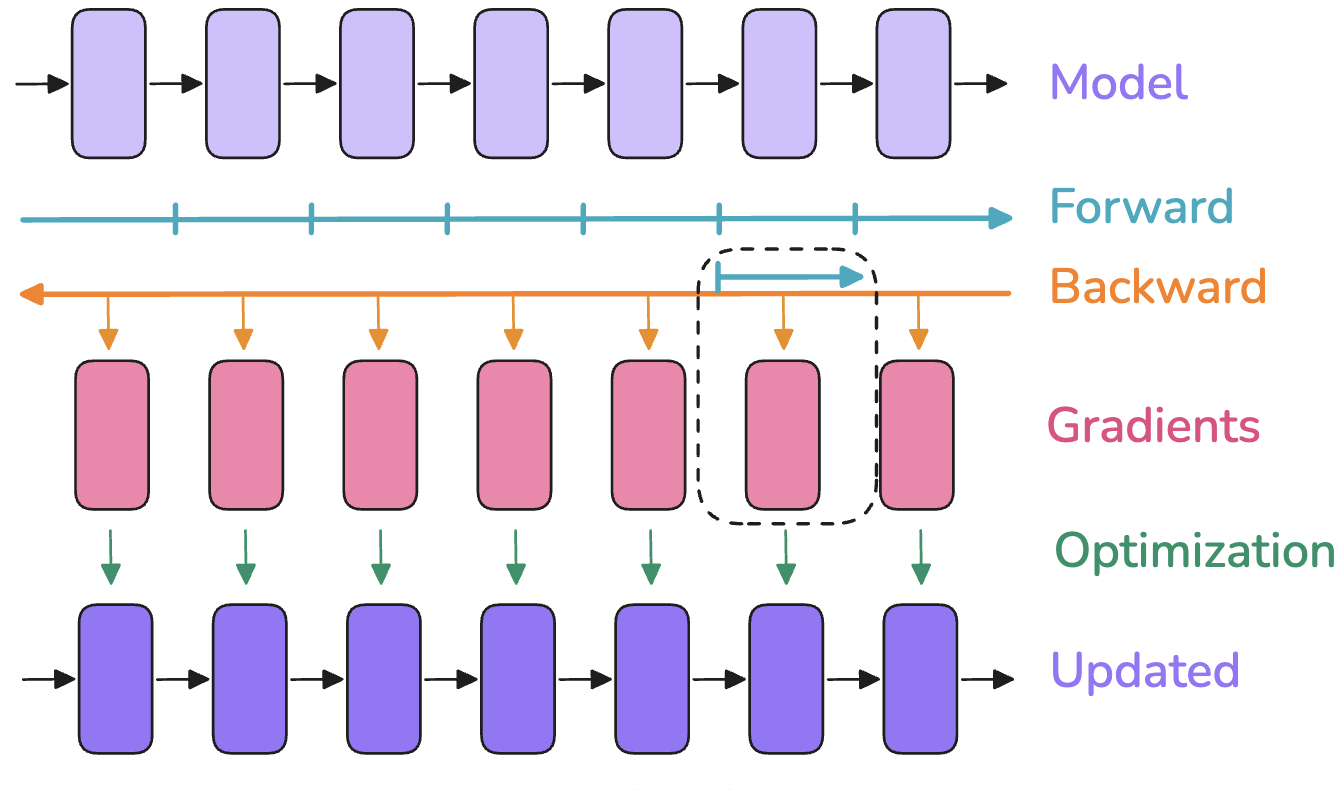 (Top: Standard backprop stores everything. Bottom: Recomputation stores less, recomputes needed values during backward pass.)
(Top: Standard backprop stores everything. Bottom: Recomputation stores less, recomputes needed values during backward pass.)
Trade-off:
- Pro: Significantly reduces activation memory footprint.
- Con: Increases computation time (roughly adds one extra forward pass for recomputed segments).
- Often essential for training very large models.
Reference: Playbook Section
Slide 16: Toolbox: Distributed Communication Primitives (Why?)
Problem: We need multiple GPUs (workers) to cooperate. They need to exchange data.
Solution: Use standard communication patterns (“collectives”).
Context:
- Group of $N$ workers, each with a rank (0 to $N-1$).
- Usually implemented by libraries like NCCL for high-speed GPU communication.
Understanding these is key to understanding parallelism strategies!
Reference: Playbook Appendix A0
Slide 17: Primitives 1: Broadcast & Reduce/AllReduce
Broadcast: One worker sends the same data to all others (including itself).
- Use case: Send initial weights from rank 0 to all.
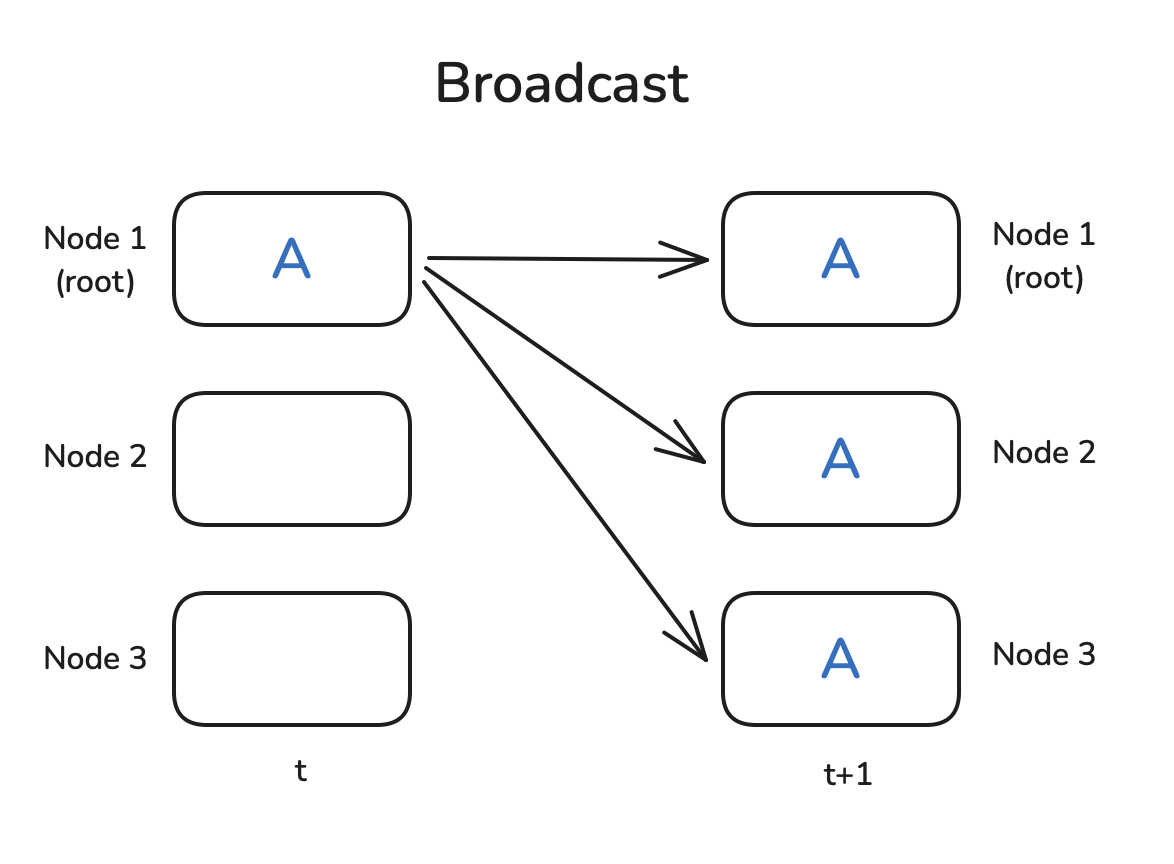
Reduce: Collect data from all workers, apply an operation (SUM, AVG), store result on one destination worker.
- Use case: Aggregate partial results onto one worker.
AllReduce: Like Reduce, but the final result is distributed back to all workers.
- Use case: Average gradients across all workers in Data Parallelism.
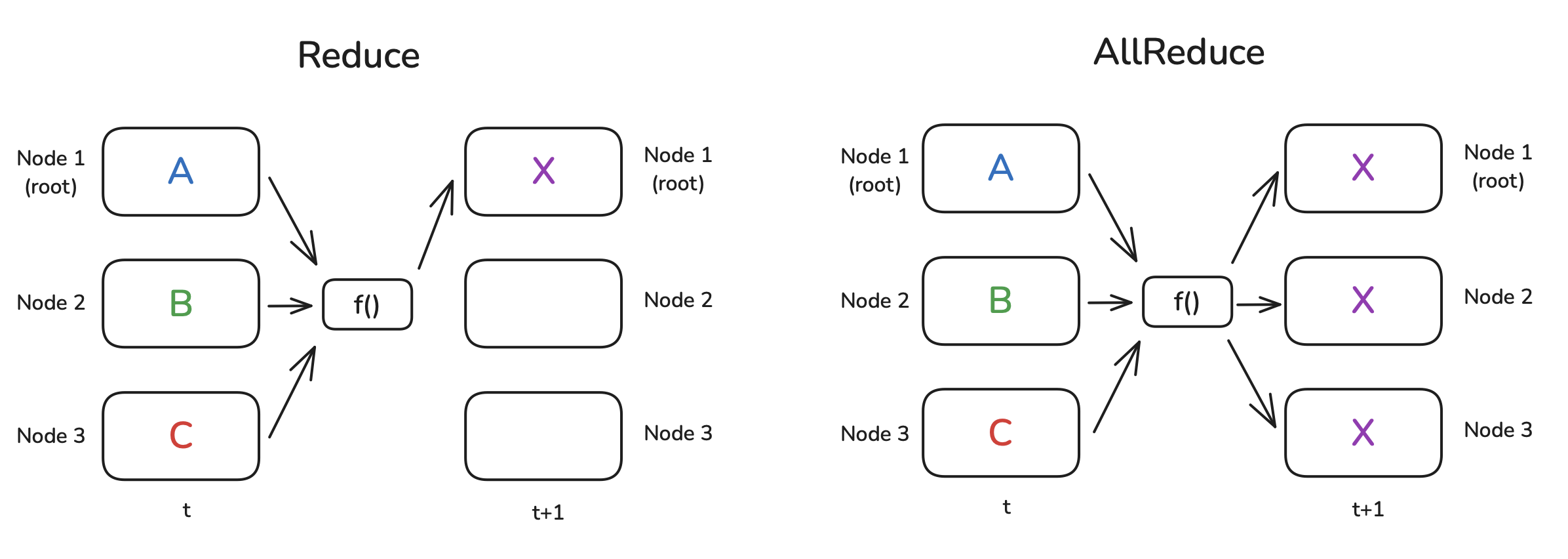
Slide 18: Primitives 2: Gather/AllGather & Scatter/ReduceScatter
Gather: Collect different data chunks from each worker onto one destination worker.
- Use case: Collect results from different workers.
AllGather: Like Gather, but the collected result (all chunks) is distributed back to all workers.
- Use case: Reconstruct a full tensor from shards held by different workers (ZeRO).
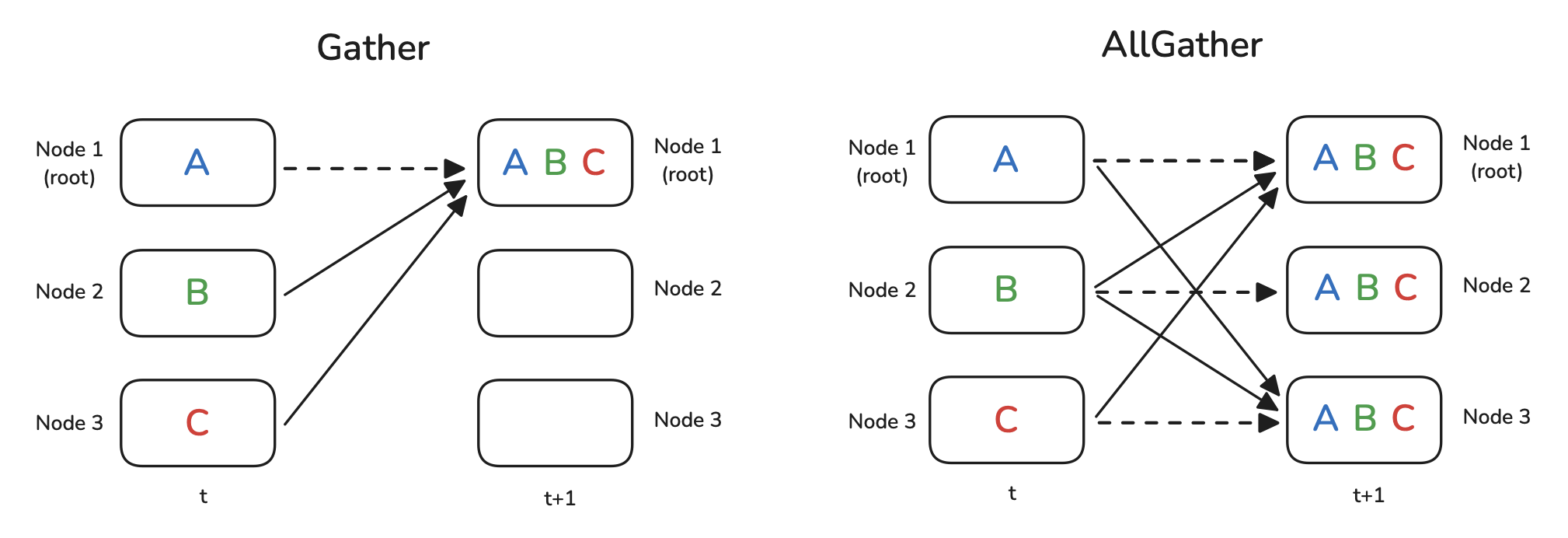
Scatter: One source worker sends different chunks of data to each worker. (Inverse of Gather).
- Use case: Distribute parts of a dataset.
ReduceScatter: Combine Reduce and Scatter. Reduce corresponding chunks from all workers, then Scatter the reduced chunk $j$ only to worker $j$.
- Use case: Compute and distribute sharded average gradients (ZeRO).
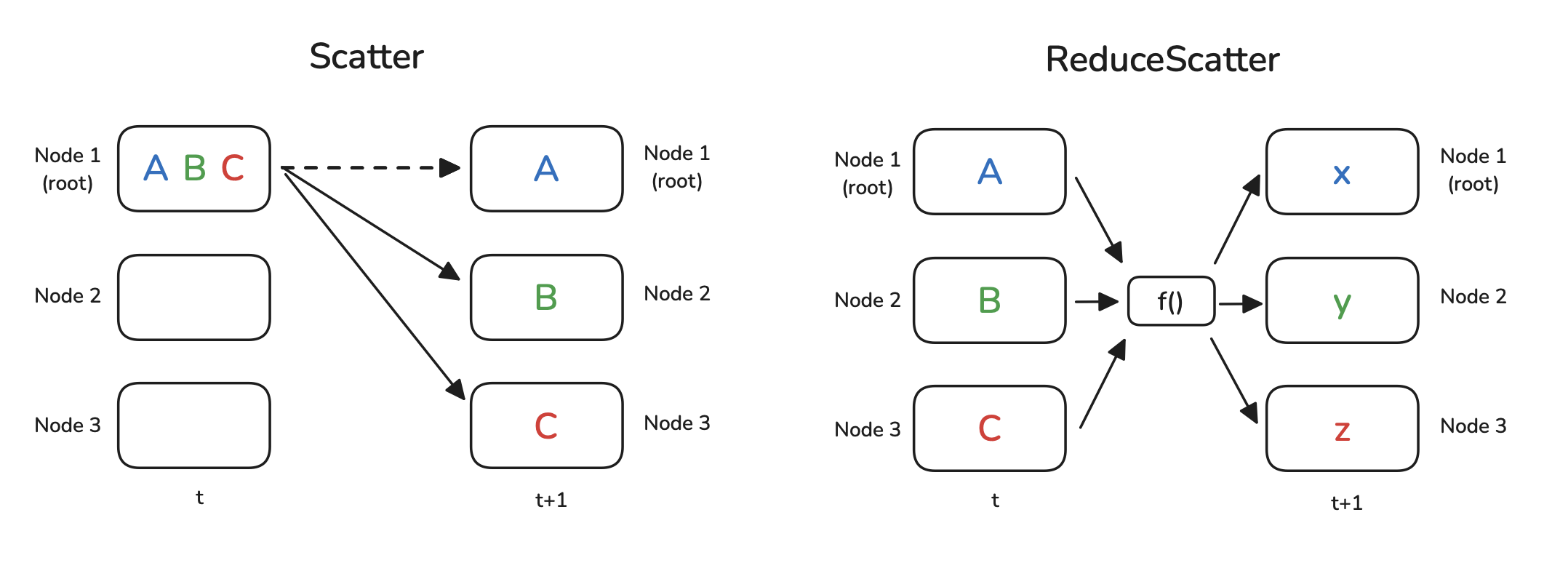
Slide 19: Primitives 3: Barrier & AlltoAll (Mentioned Later)
Barrier: Synchronization point. All workers wait here until everyone arrives.
- Use case: Ensure a stage is complete everywhere before proceeding. (Use sparingly - can cause waiting).
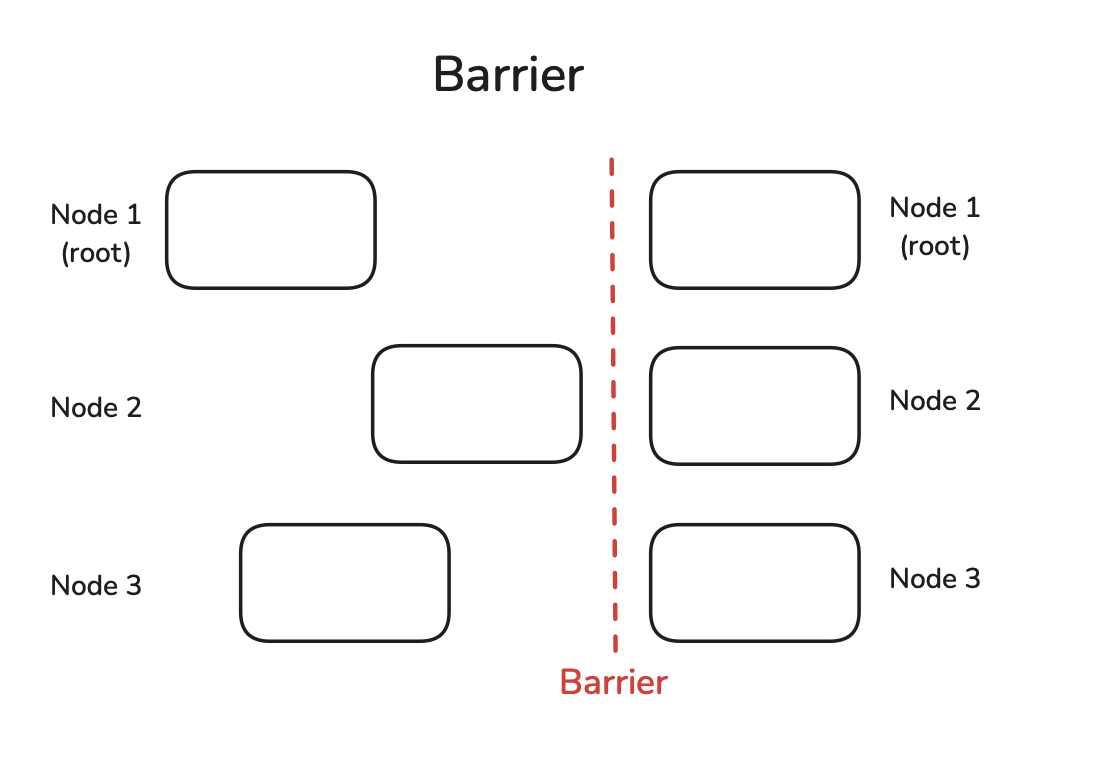
(Preview) AlltoAll: Each worker sends different data to every other worker. Worker $i$ sends chunk $j$ to worker $j$. Complex permutation.
- Use case: Routing tokens to specific “expert” networks in MoE models (Expert Parallelism).
A helpful visualization
Visualization for DP, FSDP, and TP
Slide 20: Parallelism Strategy 1: Data Parallelism (DP)
What: Replicate the entire model on each of $N_d$ workers. Split the data batch across workers. Why: Increase training throughput by processing more data in parallel. Simplest parallel strategy.
How:
- Each worker $k$ gets a micro-batch $\mathcal{B}_k$.
- Forward pass on $\mathcal{B}_k$ using local model $w \rightarrow$ Compute loss.
- Backward pass $\rightarrow$ Compute local gradient $g_k$.
- Synchronize Gradients: Average gradients across all workers: $\hat{g} = \frac{1}{N_d} \sum_k g_k$. Use
AllReduce. - Each worker updates its local model copy using the same average gradient $\hat{g}$. $w_{t+1} = \text{OptimizerStep}(w_t, \hat{g})$.
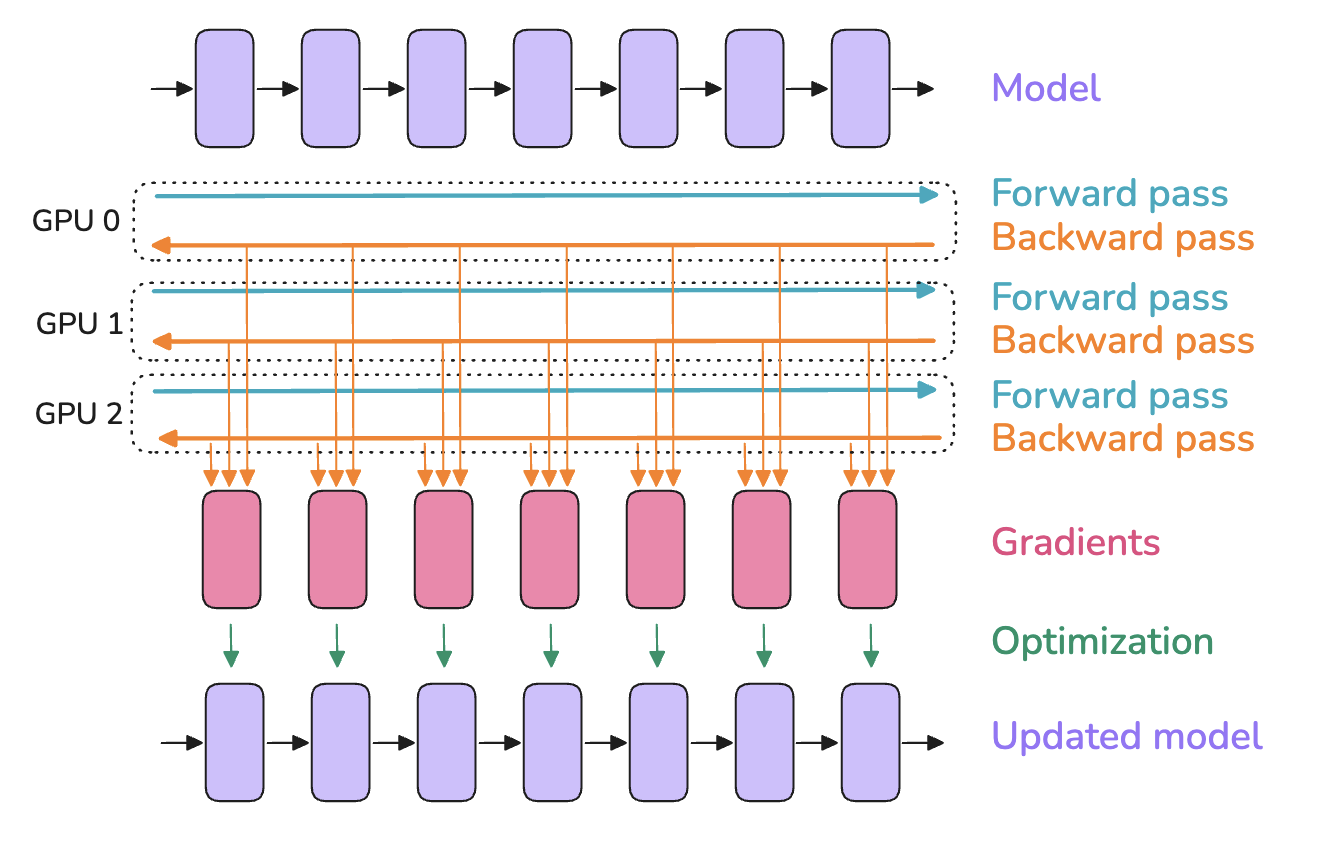
Reference: Playbook Section
Slide 21: DP Optimizations: Overlap & Bucketing
Problem: Waiting for AllReduce is slow. Communication cost scales with model size $|w|$.
Solution 1: Overlap Communication & Computation:
- Start AllReduce for gradients of later layers while backward pass computes gradients for earlier layers.
Solution 2: Gradient Bucketing:
- Group gradients into larger “buckets”.
- Perform one AllReduce per bucket instead of per tensor.
- Reduces communication call overhead, improves bandwidth use, enables better overlap.
Slide 22: DP Concept: Gradient Accumulation
Purpose: Simulate a larger effective batch size without increasing memory per worker.
How:
- Divide worker’s data $\mathcal{B}_k$ into $A$ smaller “accumulation micro-batches” $\mathcal{B}_{k,a}$.
- For $a = 1$ to $A$:
- Forward/Backward on $\mathcal{B}_{k,a}$ to get gradient $g_{k,a}$.
- Accumulate gradients locally: $g_{k}^{(A)} = \sum_{a=1}^A g_{k,a}$.
- Crucially: NO gradient synchronization (AllReduce) for steps $a=1..A-1$. (Use framework tools like
no_sync()).
- After step A: Perform one AllReduce on the accumulated gradients $g_{k}^{(A)}$.
- Perform one optimizer step using the final averaged gradient.
Trade-off: Saves memory, but takes $A$ times longer computationally for the same amount of data compared to a single large batch.
Slide 23: DP Limitations
The Big Problem: Memory Redundancy!
- Every worker stores:
- Full Model Parameters ($w$)
- Full Optimizer States ($\text{OptState}$ - e.g., Adam moments, often 2x parameter size!)
- Full Gradients ($g_k$) (at least temporarily)
- Activations ($A_k$) for its micro-batch.
- Memory usage per worker does not decrease as you add more workers ($N_d$).
- DP alone cannot train a model that doesn’t fit on a single GPU.
Communication Bottleneck: AllReduce cost scales with model size $|w|$ and can limit scaling as $N_d$ increases.
Slide 24: Parallelism Strategy 2: ZeRO (Zero Redundancy Optimizer)
What: Enhance Data Parallelism by partitioning (sharding) model state (Optimizer States, Gradients, Parameters) across DP workers ($N_d$). Eliminates memory redundancy. Why: Train much larger models under DP by reducing memory per worker.
Core Idea: Worker $k$ only owns and updates shard $(k)$ of the state.
Reference: Playbook Section
Slide 25: ZeRO Stage 1 (ZeRO-1): Partition Optimizer States
- Partitions: Optimizer States ($\text{OptState}^{(k)}$).
- Replicates: Parameters ($w$), Gradients ($g_k$).
How:
- Fwd/Bwd: Compute full local gradient $g_k$.
- Sync/Shard Gradients:
ReduceScattersums gradients and gives worker $k$ only its needed shard $\hat{g}^{(k)}$. - Optimizer Step: Worker $k$ updates only its parameter shard $w^{(k)}$ using $\hat{g}^{(k)}$ and local $\text{OptState}^{(k)}$.
- Sync Parameters:
AllGathercollects updated $w^{(k)}$ from all workers to reconstruct the full $w$ on every worker for the next step.
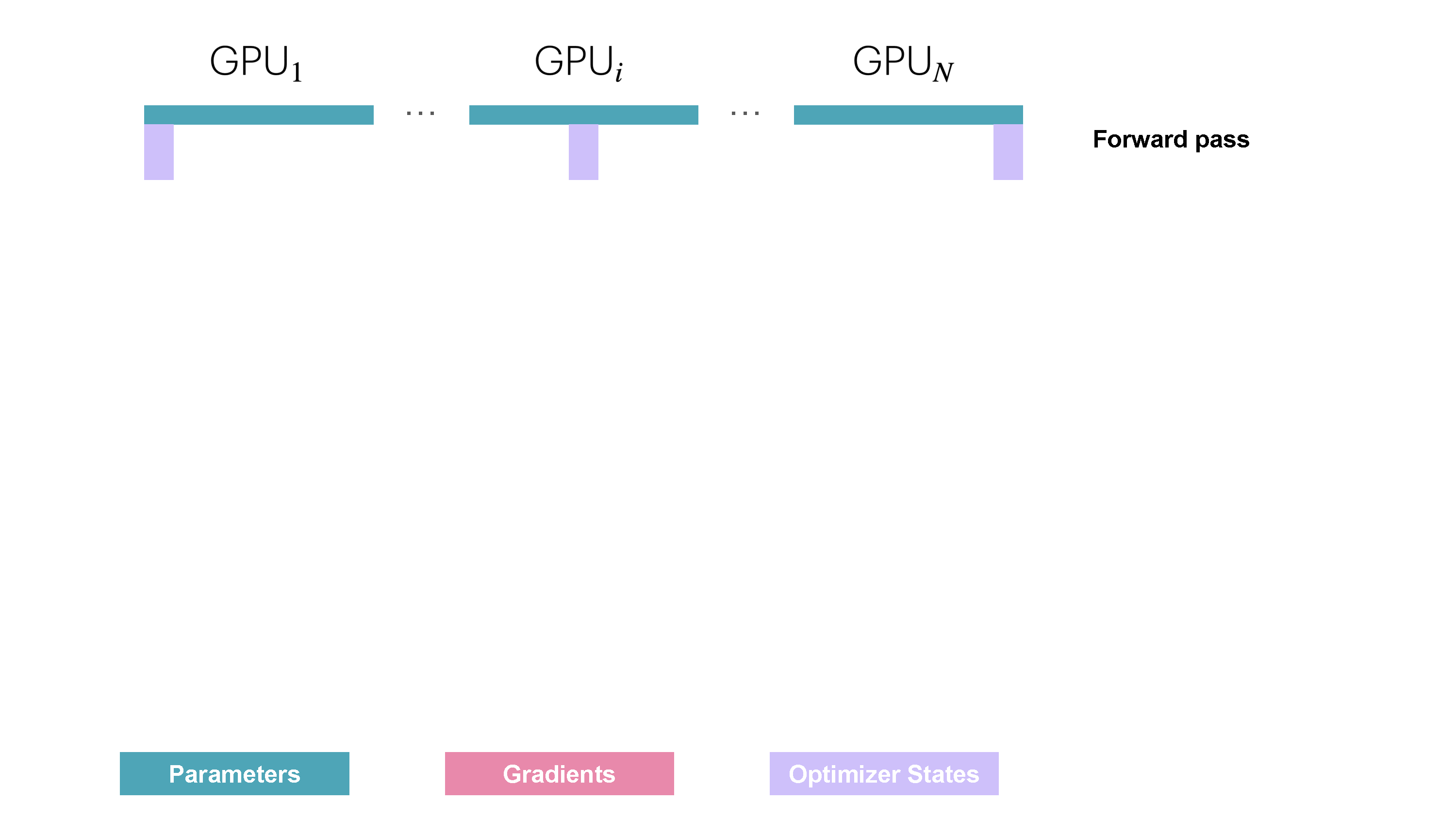
Memory Saved: Optimizer states (often the largest part!). Communication: Replaces 1 AllReduce with ReduceScatter + AllGather. Reference: Playbook Section
Slide 26: ZeRO Stage 2 (ZeRO-2): Partition Gradients Too
- Partitions: Optimizer States ($\text{OptState}^{(k)}$), Gradients ($\hat{g}^{(k)}$).
- Replicates: Parameters ($w$) (temporarily during compute).
How:
- Fwd: Compute activations $A_k$.
- Bwd & Shard Gradients: As gradients are computed,
ReduceScatterthem immediately. Worker $k$ only stores the final, averaged shard $\hat{g}^{(k)}$. (Avoids storing full $g_k$). - Optimizer Step: Update $w^{(k)}$ using $\hat{g}^{(k)}$ and $\text{OptState}^{(k)}$.
- Sync Parameters:
AllGatherreconstructs full $w$.
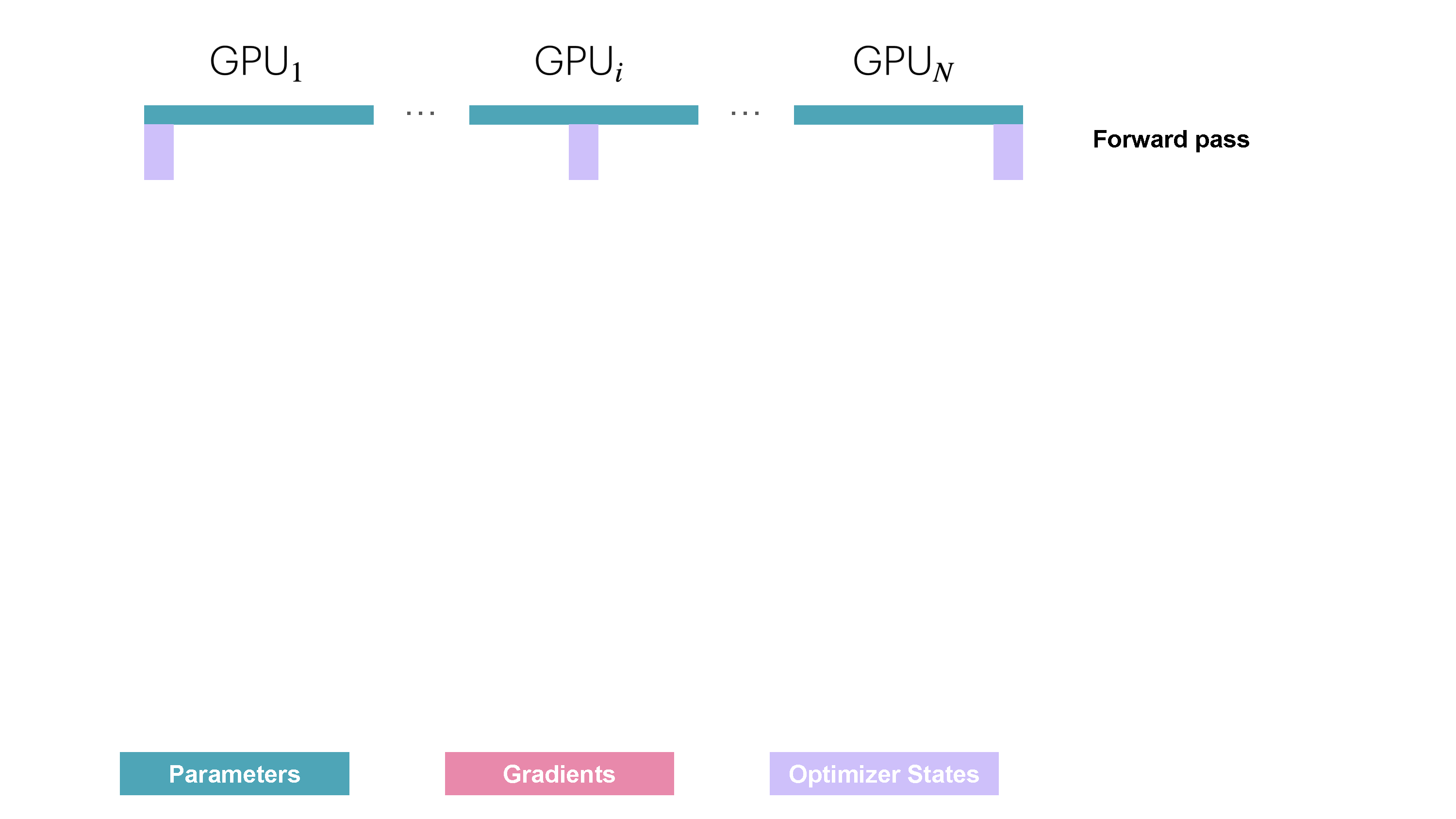
Memory Saved: Optimizer states + Gradients. Communication: Still ReduceScatter + AllGather. Reference: Playbook Section
Slide 27: ZeRO Stage 3 (ZeRO-3 / FSDP): Partition Parameters Too
- Partitions: Optimizer States ($\text{OptState}^{(k)}$), Gradients ($\hat{g}^{(k)}$), Parameters ($w^{(k)}$).
- Replicates: Nothing persistently!
How:
- Forward Pass (Per Layer/Block):
AllGatherparameters needed for the current layer ($W_j$) just before use.- Compute forward pass $A_j = f_j(A_{j-1}; W_j)$.
- Discard non-owned parameter shards immediately after use.
- Backward Pass (Per Layer/Block):
AllGatherparameters $W_j$ again.- Compute gradients.
ReduceScattergradients immediately, worker $k$ keeps only $\hat{g}_j^{(k)}$.- Discard non-owned parameter shards.
- Optimizer Step: Update local parameter shard $w^{(k)}$ using $\hat{g}^{(k)}$ and $\text{OptState}^{(k)}$. (No final parameter AllGather needed).
Memory Saved: Maximum savings - scales memory per worker by $1/N_d$. Communication: Many AllGathers (params) + ReduceScatters (grads) throughout fwd/bwd. Needs good overlap! Reference: Playbook Section
Slide 28: ZeRO Summary & Trade-offs
(Shows theoretical memory reduction per stage vs DP size N_d)
Pros:
- Massive memory savings for model state ($w, g, \text{OptState}$), enabling huge models via DP.
- ZeRO-3 offers maximum savings.
Cons:
- Increased communication volume compared to standard DP. Replaces one AllReduce with potentially many collectives (ReduceScatter, AllGather).
- Efficiency relies heavily on overlapping communication with computation.
- Does NOT partition activation memory $A_k$! Still need Activation Recomputation if activations are the bottleneck.
Slide 29: Parallelism Strategy 3: Tensor Parallelism (TP)
What: Parallelize within a single layer (e.g., matrix multiply). Partition tensors and computation across $N_{tp}$ workers. Why:
- Layer parameters/activations too large for one GPU.
- Accelerate computation within a layer.
Common Approach: Split weight matrices
-
Column Parallelism: Split weight $A$ column-wise $ [A_1 | … | A_{N_{tp}}]$. Each worker computes $Y_k = f(X A_k)$. Output $Y$ is $[Y_1 | … | Y_{N_{tp}}]$ distributed across workers. Needs AllReduce in backward pass for $\nabla_X$.
-
Row Parallelism: Split weight $A$ row-wise $ [A_1^T | … | A_{N_{tp}}^T]^T$. Input $X$ must also be sharded $[X_1 | … | X_{N_{tp}}]$. Each worker computes $Y_k = f(X_k A_k)$. Final output $Y = \sum Y_k$ requires
AllReducein forward pass.
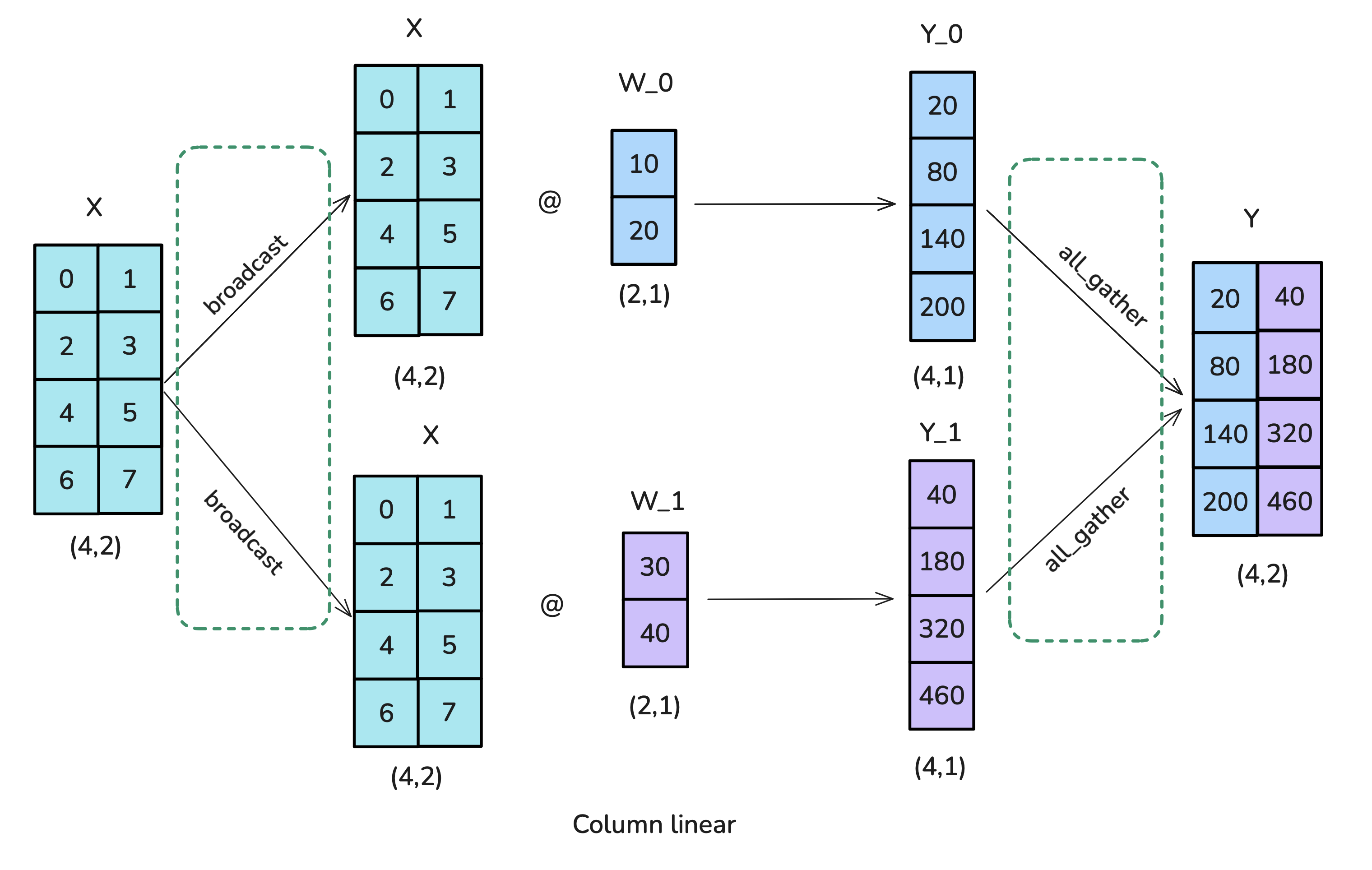
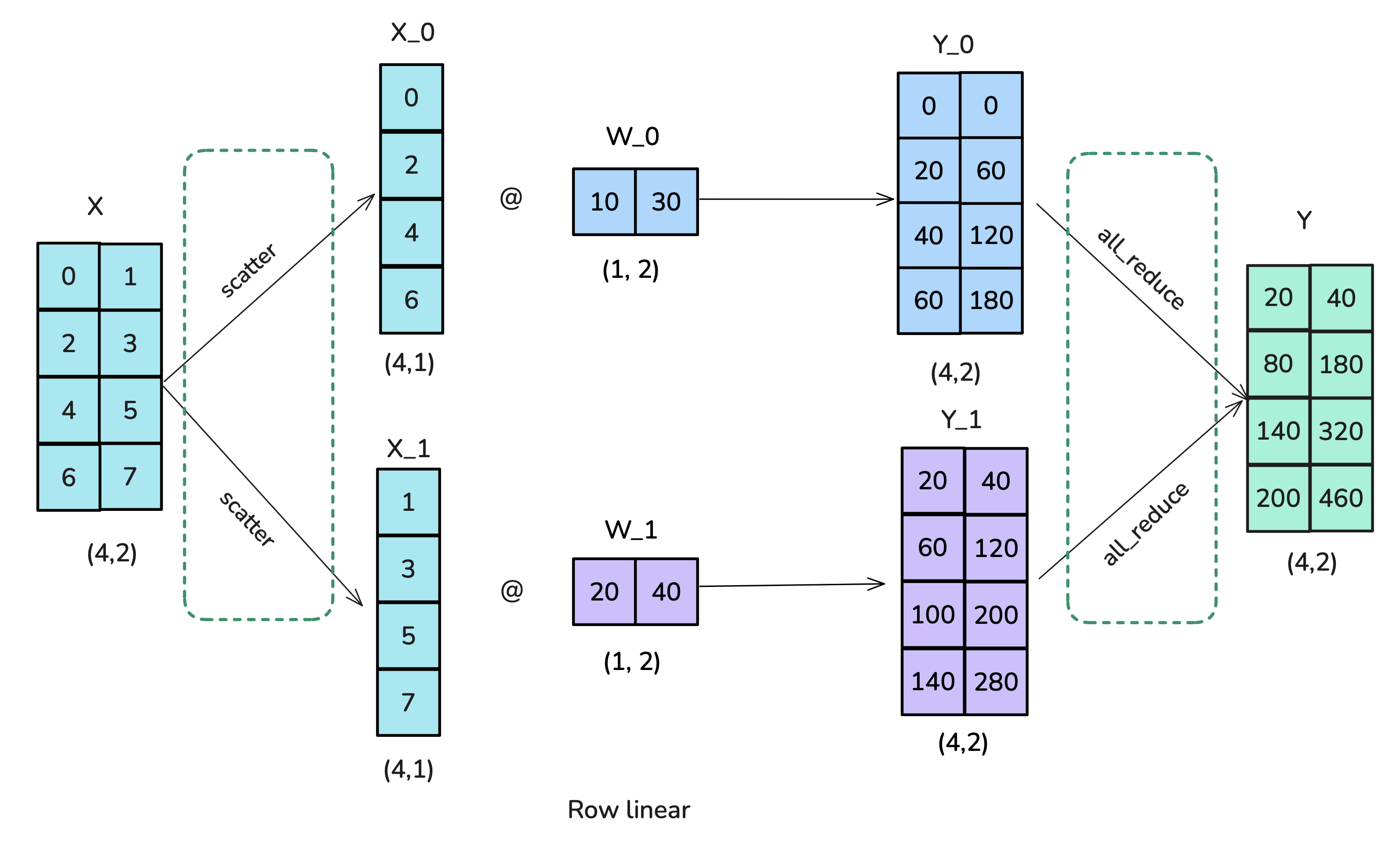
Reference: Playbook Section
Slide 30: TP Applied to Transformers (FFN & MHA)
Goal: Minimize communication between operations.
FFN ($Y = f(XW_1)W_2$):
- $W_1$ (expand): Column Parallelism. Input $X$ (replicated), Output $f(Z)$ sharded along intermediate dim $d_{ff}$.
- $W_2$ (contract): Row Parallelism. Input $f(Z)$ (sharded), Output $Y_k$ partial.
- Final $Y = \sum Y_k$ via
AllReduce.- Key: No communication needed between $W_1$ and $W_2$!
MHA:
- $W_Q, W_K, W_V$: Column Parallelism. Input $X$ (replicated), Outputs $Q_k, K_k, V_k$ sharded (effectively sharding heads).
- Attention Calc: If $N_{tp}$ divides num heads $a$, each worker computes attention for its local heads using $Q_k, K_k, V_k$. No communication needed here! (Efficient “Head-wise Parallelism”). Output $Attn_k$ sharded.
- $W_O$: Row Parallelism. Input $Attn_k$ (sharded), Output $Z_k$ partial.
- Final MHA Output $Y = \sum Z_k$ via
AllReduce.
 (Shows Column for QKV, local attn, Row for Output proj -> AllReduce. Shows Col for FFN1, Row for FFN2 -> AllReduce)
(Shows Column for QKV, local attn, Row for Output proj -> AllReduce. Shows Col for FFN1, Row for FFN2 -> AllReduce)
Slide 31: TP Trade-offs
Pros:
- Reduces memory per worker for $w, g, \text{OptState}$ and Activations $A$ (for the parallelized layers).
- Can speed up computation if communication overhead is low.
Cons:
- High Communication Frequency: Requires AllReduce within layer computations.
(Shows communication cannot be fully overlapped)
- Needs very high-bandwidth, low-latency interconnect (e.g., NVLink within a node). Usually limited to small $N_{tp}$ (e.g., <= 8).
- Increases implementation complexity.
- Doesn’t parallelize all operations easily (e.g., LayerNorm requires full hidden dim).
Slide 32: Parallelism Strategy 4: Sequence Parallelism (SP)
What: Optimization used with Tensor Parallelism (TP) to reduce activation memory further. Why: TP shards along hidden dim $h$. Operations like LayerNorm, Dropout work on full $h$, preventing activation sharding there. SP shards along sequence dim $s$ for these ops.
How: Requires communication to switch sharding:
- SP Region (e.g., LayerNorm): Input $X$ sharded along $s$. Compute LN locally.
- Transition SP -> TP (
g): UseAllGatheralong $s$ to get full tensor $Y$ (replicated) needed for TP’s column-parallel input. - TP Region (e.g., FFN): Compute TP ops (Col-Linear -> Row-Linear). Output is partial $W_k$, sharded along $h$.
- Transition TP -> SP (
g*): UseReduceScatteralong $s$. This sums partial $W_k$ (completing TP’s Row-Linear) AND scatters result along $s$. Output $W^*$ is sharded along $s$. - SP Region (e.g., Dropout): Apply Dropout locally to sequence-sharded $W^*$.
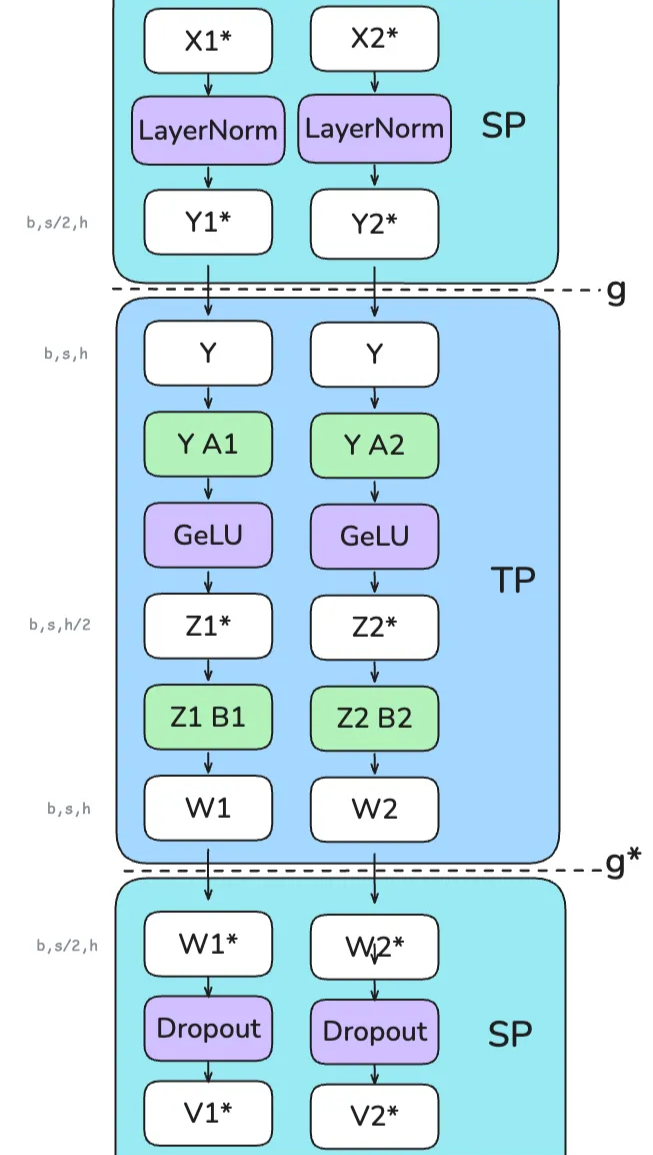
Benefit: Reduces peak activation memory by avoiding full $b \times s \times h$ tensor for LN/Dropout. Adds complexity. Communication volume similar to TP, uses AllGather/ReduceScatter instead of AllReduce. Still needs fast interconnect. Reference: Playbook Section
Slide 33: Parallelism Strategy 5: Context Parallelism (CP) & Ring Attention
What: Partition the sequence dimension $s$ globally across $N_{cp}$ workers for most computations. Why: Handle extremely long sequences ($s$) where activations ($b \times s \times h$) become prohibitive, especially in attention ($s^2$).
How:
- Worker $k$ holds sequence chunk $X_k \in \mathbb{R}^{b \times (s/N_{cp}) \times h}$.
- FFN, LN are local.
- Challenge: Attention needs all Keys ($K$) and Values ($V$).
- Solution: Ring Attention:
- Workers arranged in a ring.
- Repeat $N_{cp}-1$ times:
- Send current K/V chunk to next worker (async).
- Compute partial attention with local Q and current K/V chunk (overlap).
- Receive K/V chunk from previous worker (blocking). Update current K/V.
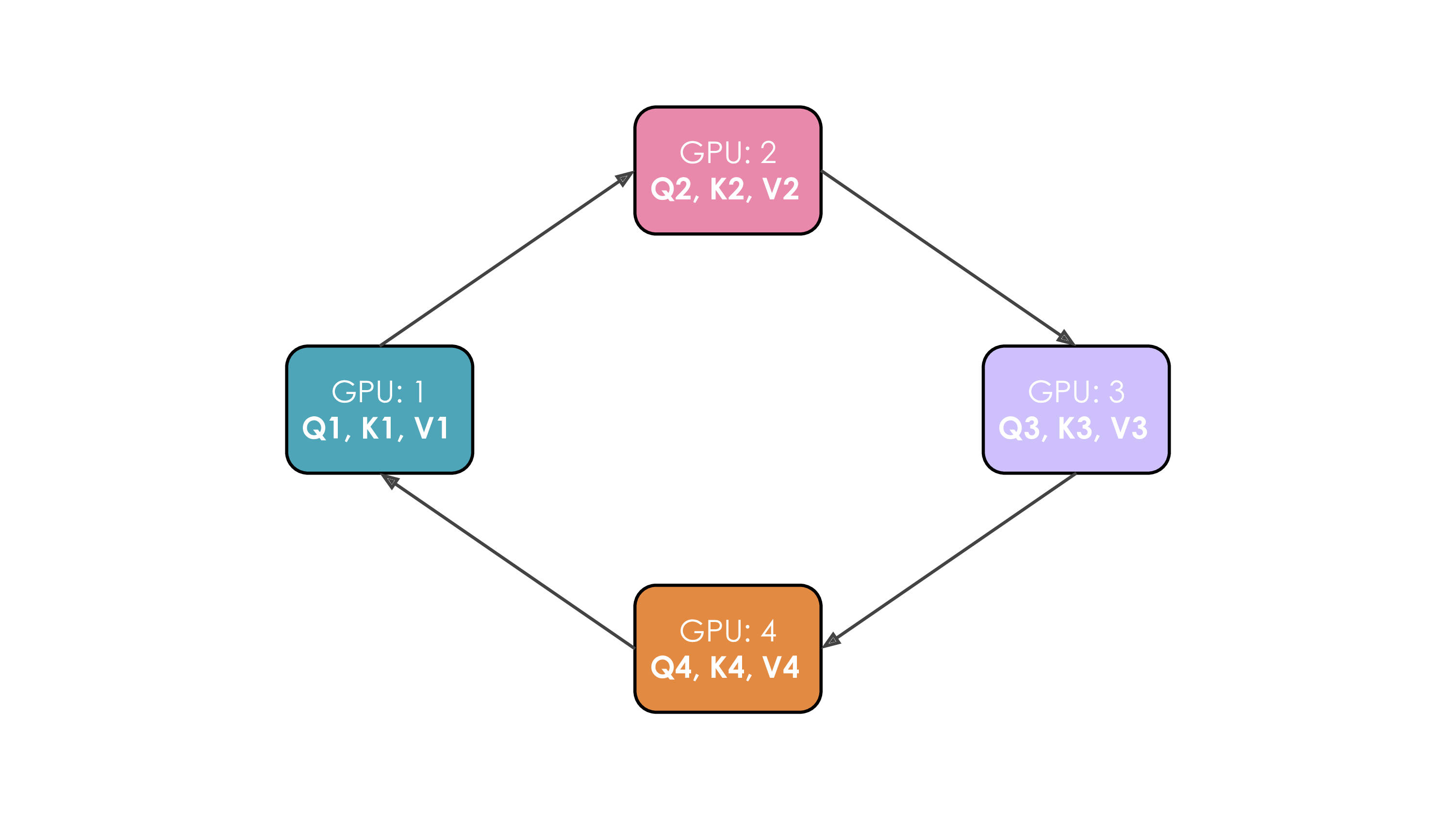
Communication: Point-to-point K/V passing + final gradient AllReduce across $N_{cp}$.
Reference: Playbook Section
Slide 34: CP Challenge: Load Balancing with Causal Masks
Problem: With causal masks (attend only to past) + naive sequential partitioning, workers with early chunks do much less work than workers with late chunks. Bad load imbalance!
(Shows GPU1 has few calcs, GPU4 has many)
Solution: ZigZag Partitioning:
- Assign sequence chunks non-contiguously, mixing early/late tokens on each worker.
- Balances the computation load across all $N_{cp}$ workers.
(Shows computation more evenly distributed)
Benefit: Enables training on very long sequences. Adds complexity to attention.
Slide 35: Parallelism Strategy 6: Pipeline Parallelism (PP)
What: Partition the model layers sequentially into $P$ stages. Stage $p$ runs on worker(s) $p$. Data flows $1 \rightarrow 2 \rightarrow … \rightarrow P$. Why:
- Model parameters $|w|$ too large for single device / TP group.
- Scale across many nodes (TP needs fast intra-node links, PP tolerates slower inter-node links).
How: Stage $p$ computes $A_p = f_p(A_{p-1}; w_p)$. Output $A_p$ is sent to stage $p+1$.
Problem: Pipeline Bubble: Naive sequential execution leaves most stages idle.
(Shows large grey idle areas)
Reference: Playbook Section
Slide 36: PP Scheduling: Reducing the Bubble
Idea: Split batch $\mathcal{B}$ into $m$ micro-batches ($\mathcal{B}^{(j)}$). Process them concurrently in the pipeline.
Schedule 1: All-Forward-All-Backward (AFAB / GPipe):
- All micro-batches do full forward pass ($F_1..F_P$).
- Then all micro-batches do full backward pass ($B_P..B_1$).
- Simple, but needs to store activations for all $m$ micro-batches. High activation memory ($\propto m$). Bubble size $\approx (P-1)/m$.
Schedule 2: One-Forward-One-Backward (1F1B / Interleaved):
- Interleave Fwd/Bwd passes more tightly. Start backward pass for micro-batch $j$ as soon as its forward pass finishes.
- Reduces peak activation memory ($\propto P$). Bubble size $\approx (P-1)/m$. More complex.
(Advanced): Interleaved Stages, ZeroBubble schedules exist - more complex, aim for zero bubble.
Slide 37: PP Trade-offs
Pros:
- Partitions very deep models across many devices/nodes.
- Communication (activations/gradients between stages) is less bandwidth-intensive than TP/FSDP collectives, suitable for inter-node networks.
Cons:
- Pipeline Bubble: Inherent inefficiency, limits perfect scaling. Requires large $m$ (many micro-batches, often via gradient accumulation) to amortize.
- Requires careful load balancing (each stage should take similar time).
- Choice of schedule impacts memory and complexity.
Slide 38: Parallelism Strategy 7: Expert Parallelism (EP)
What: Specialized strategy for Mixture-of-Experts (MoE) models ONLY. Why: Scale models to huge parameter counts by having many specialized “expert” networks (e.g., FFNs), but only activating a few per token.
MoE Layer:
- Replace FFN with $E$ expert FFNs ${f_{e}}$.
- Gating network $R(x_t)$ picks 1 or 2 experts for each token $x_t$.
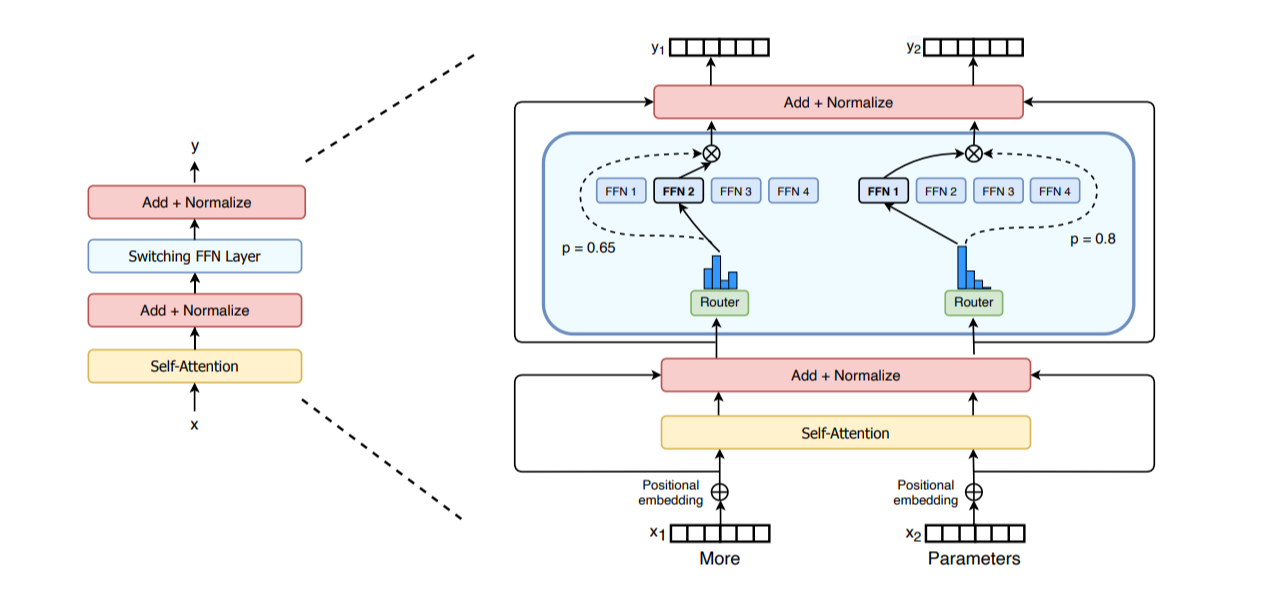
How EP Works:
- Distribute $E$ experts across $N_{ep}$ workers. Worker $k$ holds experts $E_k$.
- Gating selects expert $e(x_t)$ for token $x_t$.
AlltoAll: Route token $x_t$ to the worker holding expert $e(x_t)$.- Worker computes expert output $y_t = f_{e(x_t)}(x_t)$.
AlltoAll: Route output $y_t$ back to original worker.
Reference: Playbook Section
Slide 39: EP Trade-offs & Combination with DP
Pros:
- Massive parameter scaling with relatively low compute cost per token (sparse activation).
Cons:
- Only for MoE models.
- High Communication Cost:
AlltoAllis communication-intensive, can be a bottleneck. Requires high bisection bandwidth. - Load balancing challenges (if some experts are chosen more often).
Combination with DP:
- EP alone only parallelizes MoE layers. Non-expert layers are replicated.
- Almost always used with DP ($N_d$ workers) in a 2D grid ($N_d \times N_{ep}$).
- EP happens across workers in a DP group (row).
- DP happens across workers holding the same expert shards (column).
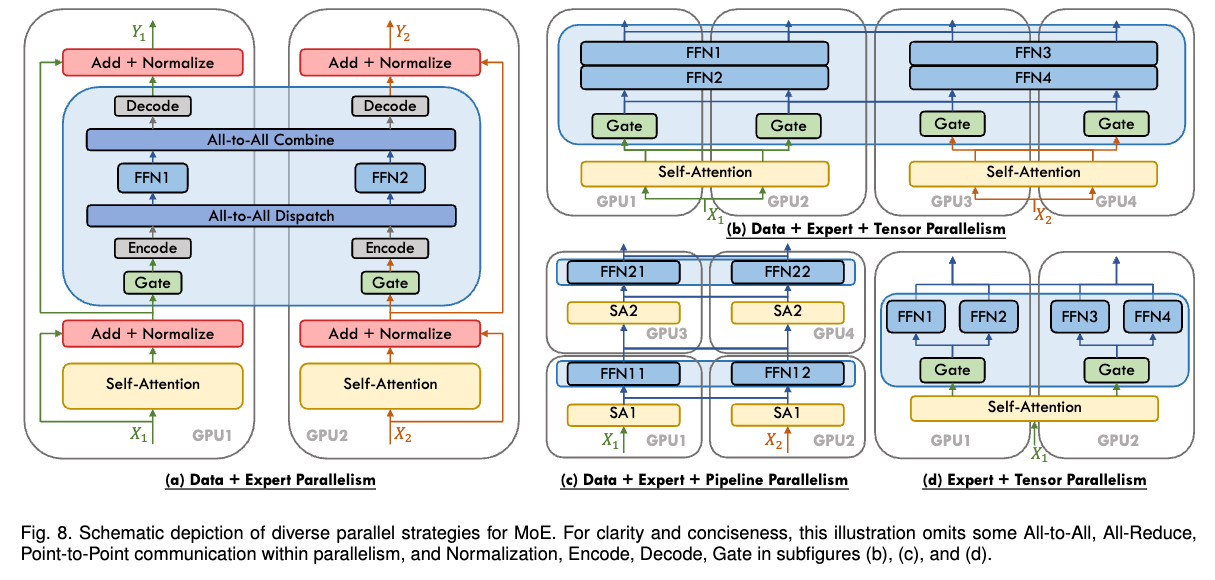
Slide 40: Combining Strategies: The Need for Hybrid Parallelism
No Silver Bullet! Each strategy has strengths and weaknesses.
- DP/ZeRO: Scales data throughput, limited by activation memory (DP) or communication (ZeRO).
- TP/SP/CP: Reduces activation/param memory per device, needs fast interconnect, limited scalability.
- PP: Scales deep models across nodes, suffers from bubble.
- EP: Scales MoE parameters, needs AlltoAll.
Solution: Combine them! Leverage hardware topology.
Common Combo: 3D Parallelism ($N = N_d \times P \times N_{tp}$)
- TP ($N_{tp}$): Within a node (uses NVLink). Partitions layers/activations.
- PP ($P$): Across nodes (uses inter-node network). Partitions layers sequentially.
- DP ($N_d$): Across nodes/racks. Replicates the PP+TP setup, processes different data.
Reference: Playbook Section
Slide 41: Role of FSDP (ZeRO-3) in Combined Strategies
- In 3D (or higher) parallelism, the “DP” dimension ($N_d$) is often implemented using FSDP (ZeRO-3) instead of standard DP.
- Why? FSDP shards parameters/gradients/optimizer states across the $N_d$ replicas.
- Benefit: Drastically reduces memory per worker compared to replicating the model state in standard DP. Allows fitting much larger models within the combined (FSDP + PP + TP) setup.
PP vs. FSDP Parameter Partitioning:
- PP: Partitions layer-wise into sequential stages. Worker $p$ holds full parameters $w_p$ for its layers. Communicates activations. Sensitive to bubble (needs high grad_acc $m$).
- FSDP: Partitions parameter-wise across DP workers. Worker $k$ holds shards $w^{(k)}$ from all layers. Communicates parameter shards (
AllGather). Sensitive to overlap (needs large micro-batchmbsor sequence lengths).
(Combining PP and FSDP is possible but complex, needs large global batch size).
Slide 42: Adding CP & EP to the Mix (Conceptual 5D)
- CP (Context Parallelism): Added when sequences ($s$) are very long. Typically partitions along DP or PP dimension workers, adds Ring Attention communication.
- EP (Expert Parallelism): Added only for MoE models. Distributes experts, often along DP dimension workers, adds
AlltoAllcommunication.
(Conceptual diagram showing how DP, PP, TP, EP, CP dimensions relate)
Slide 43: Summary Table of Parallelism Strategies
(The table summarizing What, Granularity, Communication, Pros, Cons for DP, ZeRO, PP, TP, EP)
Key Takeaway: Choosing the right mix depends on model size, architecture (MoE?), sequence length, hardware (GPU memory, interconnects), and desired batch size.
Slide 44: Finding the Best Configuration (Iterative Process)
General Approach: (From Playbook)
- Fit in Memory:
- Start with minimal setup (1 node).
- Add necessary partitioning: TP (intra-node), PP (inter-node), FSDP (across DP dim) until model parameters fit. Use ZeRO stage appropriate for memory needs.
- Use Activation Recomputation aggressively if activations are the bottleneck.
- Scale Batch Size:
- Increase DP/FSDP degree ($N_d$).
- Use Gradient Accumulation ($A$) to reach target global batch size ($GBS = N_d \times \text{per_replica_batch} \times A$).
- Add CP if sequence length ($s$) is limiting factor.
- Optimize Throughput (MFU/TFLOPS):
- Tune micro-batch sizes (for PP schedule, FSDP overlap).
- Maximize TP degree within node constraints.
- Balance PP stages for minimal bubble.
- Profile and identify communication vs. computation bottlenecks.
Reference: Playbook Section
Slide 45: Conclusion
- Training large Transformers requires overcoming single-device memory/compute limits.
- Activation Memory is often the primary bottleneck, addressed by Activation Recomputation.
- Parallelism Strategies distribute the workload:
- DP/FSDP: Distributes data/model state.
- TP/SP/CP: Distributes layer computation / activations.
- PP: Distributes layers sequentially.
- EP: Distributes MoE experts.
- State-of-the-art training uses combinations (e.g., FSDP + PP + TP) tailored to the model and hardware.
- Understanding communication primitives (
AllReduce,AllGather, etc.) and trade-offs (memory vs. compute vs. communication) is crucial. - Resources like the Ultrascale Playbook are invaluable guides.